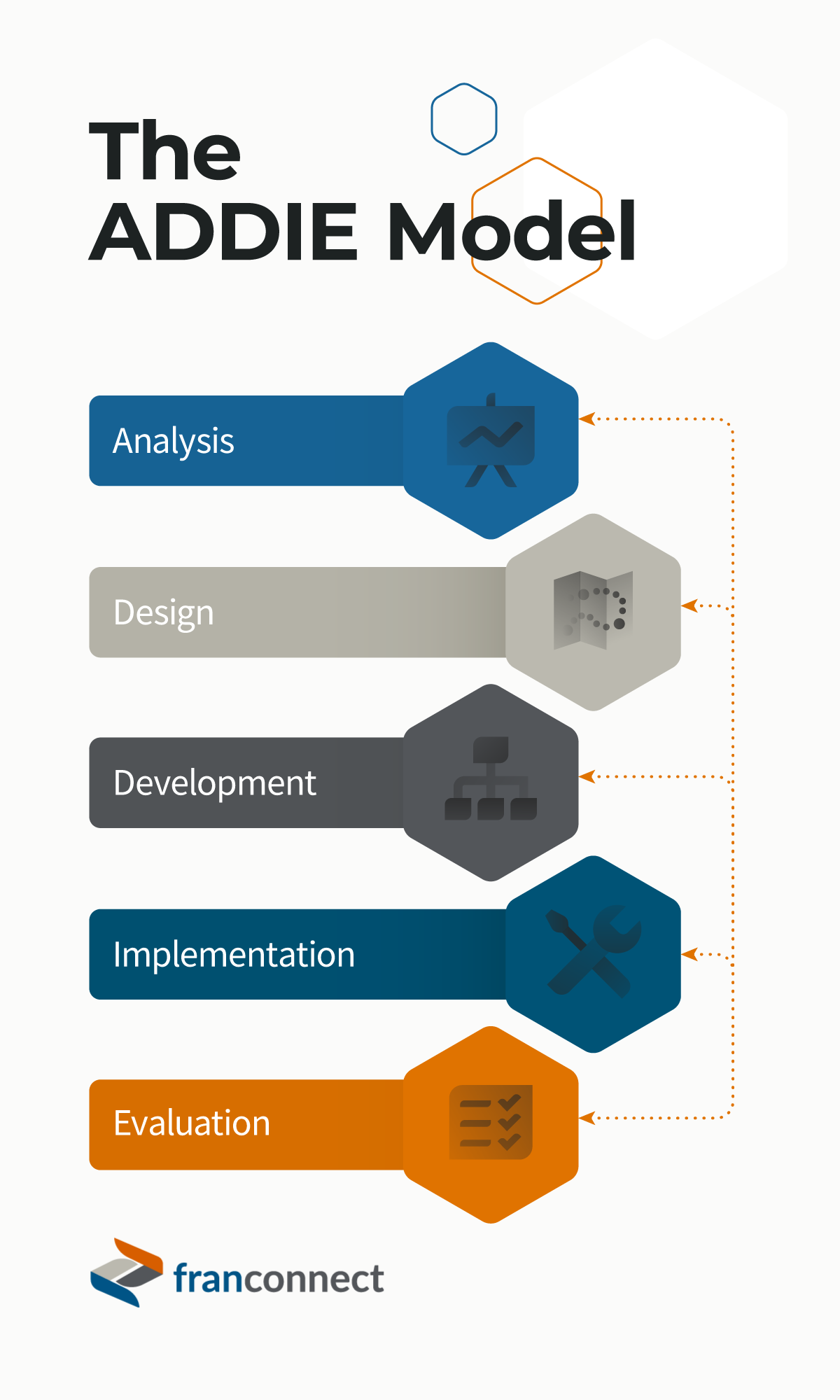
ADDIE Training Model: What Is It & How To Use It
Why Instructional Designers Love ADDIE
What instructional model do you use? There’s Bloom’s Taxonomy, Gagne’s Nine Events of Instruction, and Merrill’s Principles of Instruction. As you probably know, an instructional model is a structure or framework used by instructional designers to develop employee training programs. One of the most useful instructional models, and the focus of this blog post, is the ADDIE training model.
What does ADDIE stand for? The acronym represents each of the five stages of the instructional design process:
- Analyze
- Design
- Develop
- Implement
- Evaluate
What is ADDIE?
ADDIE is an instructional design model used to strategically organize eLearning programs and to drive course content creation. The ADDIE training model provides learning designers with an essential structure for designing curricula for any learning environment.
Let’s take a closer look at each of the five stages of ADDIE:
There are several major activities that occur at this stage. To begin with, this is when instructional designers identify the organization’s training needs and establish learning objectives to address those needs. Instructional designers gather information and make decisions that will make the training development process much smoother later on. This includes: defining who their core audience is, how the content should be customized for their particular needs, the most appropriate delivery methods, an estimated budget, and a project timeline.
During this stage, communication begins with those who may be involved in the design or implementation. This may include graphic designers and corporate trainers, among others. The information obtained in this phase is used to guide the activities of the instructional designers during the design stage.
DesignOnce you understand the training needs of your organization and have obtained initial approvals, you can design a training program tailored to meet these identified needs.
During the design stage, the instructional designer creates a blueprint for the instruction. There are several major activities included in this stage: learning content is sequenced into logical segments or units; storyboards are created for eLearning modules or training videos, and rough drafts of scripts or training outlines are created.
Once the design is approved by the stakeholders, you move on to the development stage.
Several important activities occur during the development stage. The developers create, assemble, and organize the digital and print deliverables that were begun in the design phase.
Training videos are recorded, edited, and any technical aspects of training are tested and finalized. The project documentation of the strategies is reviewed and feedback is given to the instructional designers.
This is also where continuous improvement can start. During development, piloting training materials with a focus group of employees can allow for valuable feedback and real-time iteration, resulting in a better end-product rolling out.
Once stakeholders sign off on the development strategies, the project enters the implementation stage.
ImplementThis is the stage at which your team’s training is actually delivered. During this stage, HR or other team members responsible for rolling out training make the researched, designed, and developed materials available: they implement it. This includes videos, eLearning help-aids, in-person training, and web or computer-based training modules.
It’s helpful to launch an internal awareness campaign and get people manager buy-in to ensure all teams complete appropriate training materials and exercises.
You should also make available a point of contact for employees completing training so they know where to go with questions or feedback.
EvaluateThis is where you measure the completion, efficacy, and impact of your training design, development, and implementation. Why spend all that time and money creating a training program and not track how it’s actually working? This is one of the most important stages of the ADDIE training model.
Evaluation is conducted using the formative evaluation and/or the summative evaluation. The formative evaluation allows those involved in the training or curriculum development to recognize potential barriers to the training before they happen, respond to training challenges as they occur, and make course corrections as needed.
The summative evaluation focuses on examining the outcome of the training during the implementation stage; the information gathered from the summative evaluation continues to guide the project design process.
Note: Evaluation may overlap and intersect with the four other stages of the training process. In the ADDIE model, these stages are not always linear; they build off one another.

ADDIE, In Practice
To see how the ADDIE process works in practice, let’s use LMS implementation as an ADDIE model example. If this term is new to you, an LMS is a learning management system – essentially, an online portal for designing and administering employee training programs. Implementing an LMS is not difficult, but there are a lot of moving parts to keep track of. Let the ADDIE methodology drive the process.
Analyze
Consider the current situation. What is the organization currently doing to address its training needs? What are the priority gaps and how will deploying an LMS help close them?
Based on this discussion, clarify target audiences and determine goals for your LMS. For example, one goal might be: “Streamline and automate key training processes including onboarding, reporting and analytics, employee appraisals, and exit surveys.”
Design
Use this stage to design your LMS Implementation Action Plan. Begin by bringing together key stakeholders from HR and L&D, since they will be creating and managing the training.
- How will the LMS be used?
- How will new users be added to the system?
- What kind of authoring tools and social learning features do we need? What features does the LMS come equipped with?
- What software integrations will be needed?
- If the LMS includes gamification tools, how will they be used to engage and motivate your audience?
- When will the LMS be launched and to whom?
Develop
This is where the real work begins. In collaboration with your vendor, get your LMS tools, features, and software integrations set up. Upload content and prepare for enrollments. Do a trial run.
Implement
If you have your ADDIE game plan in hand and completed all the other steps, the implementation should be smooth and seamless, assuming you selected the right LMS vendor. They are there to hold your hand and make sure everything goes according to plan.
Evaluate
- Gain feedback from employees: what worked and what didn’t?
- How can LMS implementation be improved?
- Evaluate LMS features: which were the most popular? What was underused and why?
Conclusion: Is it Worth it?
What’s so appealing about the ADDIE learning model, as you can see, is how straightforward and intuitive the model is. It is a strategic process, based on measurable learning objectives, and a catalyst for quality design. If you want to design and implement an effective training program through an easy-to-follow, proven process, ADDIE is worth it.
Book a demo today to learn how the World Manager LMS can streamline and supercharge your company’s employee training program.













